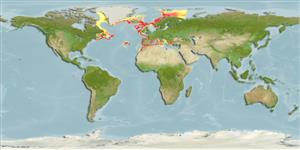Environment: milieu / climate zone / depth range / distribution range
Ecología
marino demersal; no migratorio; rango de profundidad 150 - 1000 m (Ref. 54594), usually 350 - 500 m (Ref. 54594). Temperate; 79°N - 29°N, 65°W - 44°E (Ref. 54594)
Northeast Atlantic: Southwestern Barents Sea, sometimes north to Spitsbergen, southeastern Greenland, southern coast of Iceland, around the British Isles and south to Morocco and into the western Mediterranean. Northwest Atlantic: Newfoundland.
Length at first maturity / Tamaño / Peso / Age
Maturity: Lm 86.5 range ? - 88 cm
Max length : 155 cm TL macho / no sexado; (Ref. 1371); peso máximo publicado: 30.0 kg (Ref. 35388); edad máxima reportada: 20 años (Ref. 1371)
Espinas dorsales (total) : 0; Espinas anales: 0; Radios blandos anales: 70 - 81. Lower jaw longer than upper jaw; barbel shorter than eye diameter. Back gray-brown, grading to white ventrally. Posterior portions of vertical fins dark with pale margins.
Found mostly from 350-500 m depth on muddy bottoms. Feed on crustaceans and fish (flatfishes, gobies, rocklings) (Ref. 1371).
Life cycle and mating behavior
Madurez | Reproducción | Puesta | Huevos | Fecundidad | Larva
Cohen, D.M., T. Inada, T. Iwamoto and N. Scialabba, 1990. FAO species catalogue. Vol. 10. Gadiform fishes of the world (Order Gadiformes). An annotated and illustrated catalogue of cods, hakes, grenadiers and other gadiform fishes known to date. FAO Fish. Synop. 125(10). Rome: FAO. 442 p. (Ref. 1371)
IUCN Red List Status (Ref. 130435: Version 2024-1)
Threat to humans
Harmless
Human uses
Pesquerías: comercial
Herramientas
Special reports
Download XML
Fuentes de Internet
Estimates based on models
Preferred temperature (Ref.
123201): 2.1 - 14.1, mean 6.3 °C (based on 199 cells).
Phylogenetic diversity index (Ref.
82804): PD
50 = 0.6250 [Uniqueness, from 0.5 = low to 2.0 = high].
Bayesian length-weight: a=0.00302 (0.00171 - 0.00533), b=3.03 (2.87 - 3.19), in cm total length, based on LWR estimates for this species & (Sub)family-body (Ref.
93245).
Nivel trófico (Ref.
69278): 4.5 ±0.6 se; based on diet studies.
Resiliencia (Ref.
120179): Bajo, población duplicada en un tiempo mínimo de 4.5-14 años (K=0.13-0.16; tm=8-11; tmax=20).
Prior r = 0.31, 95% CL = 0.20 - 0.46, Based on 3 full stock assessments.
Fishing Vulnerability (Ref.
59153): Very high vulnerability (75 of 100).
Climate Vulnerability (Ref.
125649): Moderate to high vulnerability (47 of 100).
Nutrients (Ref.
124155): Calcium = 16.4 [8.1, 35.6] mg/100g; Iron = 0.278 [0.142, 0.592] mg/100g; Protein = 17.6 [15.8, 19.3] %; Omega3 = 0.381 [0.204, 0.707] g/100g; Selenium = 29.8 [15.2, 59.6] μg/100g; VitaminA = 10.9 [2.7, 40.8] μg/100g; Zinc = 0.305 [0.198, 0.473] mg/100g (wet weight);
